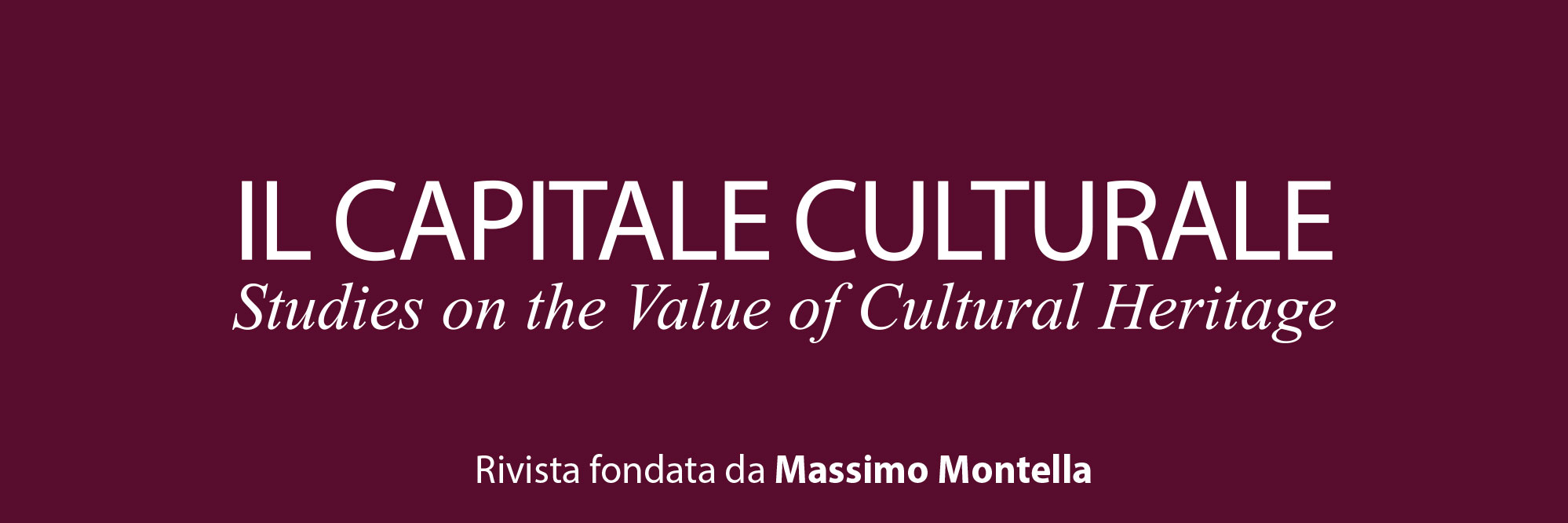Creativity as a tool of local empowerment and socio-cultural revitalization: a study of a peripheral neighbourhood in Catania
Downloads
Additional Files
- Fig. 1. Map Librino South
- Fig. 2. Map Librino North
- Fig. 3 Librino: Planimetry of Piccinato’s Plan
- Fig. 4. Picture of the district
- Fig. 5. Picture of the district
- Fig. 6. Picture of the district, “il Palazzo di cemento”
- Fig. 7. Picture of the district, inside “il Palazzo di cemento”
- Fig. 8. From a bridge to a work of art
- Fig. 9. The idea of the Museum of Image
- Fig. 10. The idea of the Museum of Image
- Fig. 11. The foundation’s website with Librino children
Pubblicato
Fascicolo
Sezione
Licenza
Tutti i materiali pubblicati sono coperti da copyright, mantenuto dall'Università di Macerata che ne supporta finanziariamente e tecnicamente la pubblicazione.
La licenza adottata è la Creative Commons - Attribuzione/Condividi allo stesso modo. Ovvero, gli autori che pubblicano su questa rivista accettano le seguenti condizioni:
- Gli autori mantengono i diritti sulla loro opera e cedono alla rivista il diritto di prima pubblicazione dell'opera, contemporaneamente licenziata sotto una Licenza Creative Commons - Attribuzione che permette ad altri di condividere l'opera indicando la paternità intellettuale e la prima pubblicazione su questa rivista.
- Gli autori possono aderire ad altri accordi di licenza non esclusiva per la distribuzione della versione dell'opera pubblicata (es. depositarla in un archivio istituzionale o pubblicarla in una monografia), a patto di indicare che la prima pubblicazione è avvenuta su questa rivista.
- Gli autori possono diffondere la loro opera online (es. in repository istituzionali o nel loro sito web) prima e durante il processo di submission, poiché può portare a scambi produttivi e aumentare le citazioni dell'opera pubblicata.
DOI:
https://doi.org/10.13138/2039-2362/780Abstract
This paper deals with the geo-territorial analysis of the impacts exerted by cultural policies in a deeply marginalised suburban neighbourhood in Catania, called Librino, where in recent years many creativity-based projects have been attempting at containing socio-economic marginalisation. In fact, a no profit foundation, local actors and civic associations promoting these projects aim at limiting the deeply-rooted disadvantages of the territory, by involving the local community, particularly the youth, in art-based activities and events. Thus, this work aims at highlighting the effects of these projects, analysed within the theoretical frame of urban and geographical studies about peripheries, by tracing the urban history of this satellite quarter and its recent evolution thanks to the brand of art and creativity.
Il presente lavoro si basa sull’analisi geo-territoriale degli impatti esercitati dalle politiche culturali in un quartiere profondamente emarginato della periferia di Catania, chiamato Librino, dove negli ultimi anni molti progetti basati sulla creatività hanno tentato di arginare la marginalità socio-economica. Infatti, una fondazione non profit, gli attori locali e le associazioni civili che promuovono questi progetti mirano a limitare gli svantaggi insiti nella condizione di marginalità del territorio, attraverso il coinvolgimento della comunità locale, in particolare i giovani, in eventi e attività improntati all’arte. In particolare, il presente lavoro è finalizzato a evidenziare gli effetti di tali progetti, analizzati nell’ambito della cornice teorica degli studi urbani e geografici sulle periferie, tracciando un affresco dell’evoluzione storica di questo quartiere satellite e della sua configurazione attuale grazie al brand dell’arte e della creatività.
Riferimenti bibliografici
Amato F., Sommella R. (2013), Periferizzazione del tempo libero e spazi metropolitaninell’area napoletana, in Percorsi creativi di turismo urbano. Creative paths of urban tourism. I luoghi dell’entertainment nella città del tempo libero, a cura di C. Cirelli, M. Giannone, E. Nicosia, Bologna: Pàtron, pp. 53-64.
Bianchini F., Dawson J., Evans R. (1992), Flagship projects in urban regeneration, in Rebuilding the City: property-led urban regeneration, edited by P. Healey, S. Davoudi, M. O’Toole, S. Tavsanoglu, D. Usger, London: E&FN Spon, pp. 245-255.
Bianchini F., Parkinson M., edited by (1993), Cultural Policy and Urban Regeneration: the West European Experience, Manchester: Manchester University Press.
Cirelli C., Mercatanti L., Nicosia E. (2008), Centralità e marginalità. L’antinomia del quartiere storico San Berillo di Catania, in Sostenibilità e Governo Urbano. L’Emilia Romagna tra teoria e buone pratiche, a cura di S. Gaddoni, F. Miani, Bologna: Pàtron, pp. 341-356.
Cirelli C., Mercatanti L., Nicosia E., Porto C.M. (2011), Urban regeneration and commerce in Catania, in Planning for Retail Resilience and Sustainable Cities,edited by T. Barata Salgueiro, H. Cachinho, Lisboa: IGOT, pp. 253-271.
Clementi A., Perego P., a cura di (1990), Eupolis. La riqualificazione delle città in Europa. Periferie oggi, Roma-Bari: Laterza.
Cremaschi M. (2001), Quartiere e territorio nei programmi integrati, «Territorio», n. 19, pp. 38-44.
Cresme (2000), Scenari e strategie d’intervento per la riqualificazione delle periferie in Italia, Rapporto finale di ricerca, Roma.
Evans G. (2005), Measure for Measure: Evaluating the Evidence of Culture’s Contribution to Regeneration, «Urban Studies», 42, n. 5/6, pp. 959-983.
Evans G. (2007), Creative spaces, tourism and the city, in Tourism, Creativity andDevelopment, edited by G. Richards, J. Wilson, London: Routledge, pp. 57-72.
Farinelli F. (2003), Geografia. Un’introduzione ai modelli del mondo, Torino: Einaudi.
Featherstone M. (1991), Consumer Culture and Postmodernism, London: Sage.
Florida R. (2002), The Rise of the Creative Class: And How It’s Transforming Work, Leisure, Community and Everyday Life, New York: Basic Books.
Hall P. (1998), Cities in Civilisation: Culture, Innovation and Urban Order, London: Weidenfeld and Nicholson.
Hall T., Robertson I. (2001), Public art and urban regeneration: advocacy, claims and critical debates, «Landscape Research», 26, n. 1, pp. 5-26.
Harvey D. (1989), The Condition of Postmodernity, Oxford: Blackwell.
Healy K. (2002), What’s new for culture in the new economy, «Journal of Arts Management, Law and Society», 32, pp. 86-103.
Inguaggiato V. (2009), Fare città, chiamarla arte. Politiche ed esperienze di integrazione tra arte e territorio, dissertazione finale del Dottorato di Ricerca in Pianificazione Urbana, Territoriale e Ambientale – XXI Ciclo, Politecnico di Milano.
Landry C., Bianchini F. (1995), The Creative City, London: Demos.
Landry C. (2000), The Creative City, London: Earthscan Publishers.
Lash S., Urry J. (1994), Economies of Signs and Spaces, London: Sage.
Lavanga M. (2004), Creative Industries, Cultural Quarters and Urban Development: the Case Studies of Rotterdam and Milan, in Urban Management in Europe Vol. II, Towards a Sustainable Development, edited by G. Mingardo, M. van Hoek, Rotterdam: Erasmus Universiteit Rotterdam.
Miles M. (1997), Art, Space and the City, London: Routledge.Nigrelli F.C. (2001), Catania: Un futuro da metropoli, in Catania. I quartieri nella metropolis, a cura di R. D’Amico, Catania: Le Nove Muse Editrice, pp. 85-109.
Osorio A.E. (2013), Creative Revitalization as a Community Affair, in Creative Economies in post-industrial cities. Manufactoring a (Different) Scene, edited by M.M. Breitbart, London: Ashgate, pp. 183-207.
Perroux F. (1961), L’économie du XX siècle, Paris: Puf.
Picone M. (2011), Storie di quartiere, «Geotema», 41, pp. 80-87.
Ruggiero V., Cirelli C. (1989), Funzioni urbane e strutture commerciali al dettaglio nella città di Catania, in La differenziazione dei prezzi finali dei beni del settore agroalimentare nelle aree urbane, Catania: CERSSAM, pp. 39-73.
Scott A.J. (1997), The Cultural Economy of Cities, «International Journal of Urban and Regional Research», 21, n. 2, pp. 323-340.
Scott A.J. (2000), The cultural economy of cities: Essays on the geography of image producing industries, London: Sage.
Sommer D. (2005), Art and accountability, «Literature and Arts of the Americas», 71, 38, n. 2, pp. 261-276.




